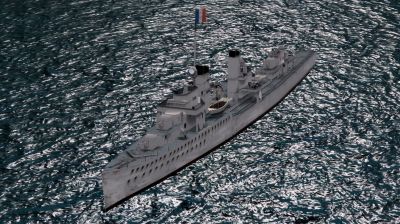Difference between revisions of "Aigle Destroyer"
| Line 23: | Line 23: | ||
=Game Play= | =Game Play= | ||
These light Destroyers were similar in size and armament to their German counterpart the Z34. Like it they were very effective in convoy escort and attack, providing AA cover for fleet operations and utilizing the ability to mount torpedo attacks against other shipping. It can carry troops during amphibious operations also, as we see often employed with the other boats in Battleground Europe. | These light Destroyers were similar in size and armament to their German counterpart the Z34. Like it they were very effective in convoy escort and attack, providing AA cover for fleet operations and utilizing the ability to mount torpedo attacks against other shipping. | ||
<br>It can carry troops during amphibious operations also, as we see often employed with the other boats in Battleground Europe. | |||
<br> | |||
<br> | |||
<br> | <br> | ||
<br> | <br> | ||
Revision as of 07:19, 4 February 2024
History
A light escort type the Aigle-class destroyers (contre-torpilleurs) were built for the French navy during the 1920s. They were very similar to the previous Guepard class, the only difference being improved machinery with higher pressure boilers, offering an additional 0.5 knots (0.93 km/h; 0.58 mph) of speed and a new model 138 mm gun with a sliding breech block giving a higher rate of fire. The ships were named after birds.
Game Play
These light Destroyers were similar in size and armament to their German counterpart the Z34. Like it they were very effective in convoy escort and attack, providing AA cover for fleet operations and utilizing the ability to mount torpedo attacks against other shipping.
It can carry troops during amphibious operations also, as we see often employed with the other boats in Battleground Europe.
Crew Insights
Here is a detailed explanation on the type of crew and the Armament it controls.
- Position 1. Helmsman - Not much explanation required, from here you can turn the Engine On/Off and navigate the Boat.
- Position 2. Lookout - This Crew is Equipped with Binoculars.
- Position 3. Forward Fire Control - This Position would be the 3 Forward facing 128mm Deck Guns. Using the Primary Fire Key would command the 2 Bow (Front) Deck Guns while the Secondary Fire Key would use the Aft (rear) forward facing Deck Gun.
- Position 4. Bow Anti-Air Gunner - This Controller commands 2x 20mm Anti-Air Gun, Primary Fire Key would command the Port (Left) Anti-Air Guns
- Position 5. Aft Anti-Air Gunner - Again this Controller commands 2x 20mm Anti-Air Gun, Primary Fire Key would fire the forward gun and the Secondary Fire Key the rear Gun.
- Position 6. Port/Starboard Fire Controller - The Controller commands 2x 37mm Deck Guns. Primary Fire Key would fire the Starboard gun and the Secondary Fire Key the Port Gun.
- Position 7. Rear Fire Control - This Position would be the 2 Rear facing 128mm Deck Guns. Using the Primary Fire Key would command the rear most Deck Guns while the Secondary Fire Key would use the other.
- Position 8. Torpedo Controller - This would control the 2x 533mm Torpedo launchers. The Primary Fire Key would command the forward most launcher while the Secondary Fire Key would use the rear most.
